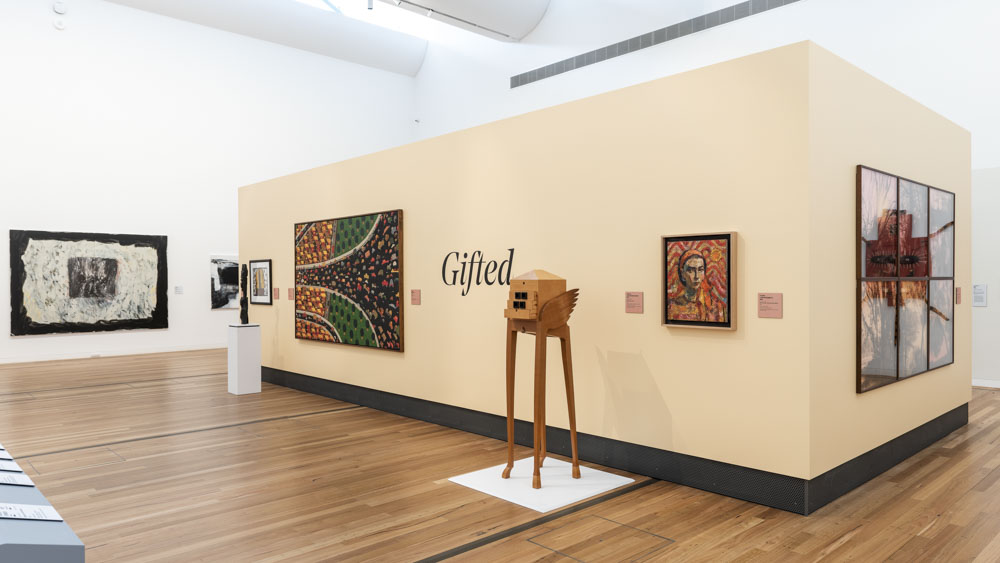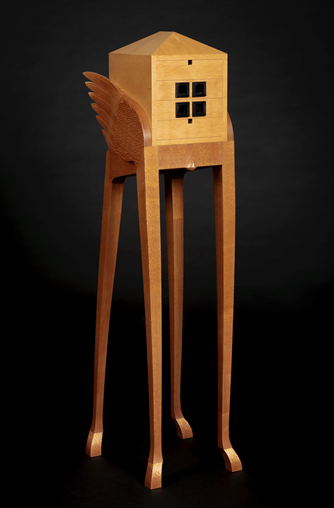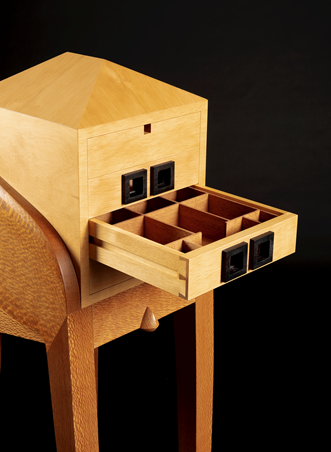Mnemosyne’s Gift



Queensland Silky Oak, Huon Pine Veneer, Glass
March 2015
H 1570 mm, W 450mm, D 470 mm.
This work was conceived as a sort of afterword, a summing up of some of the core themes represented at a survey exhibition mounted by John M. Cunningham, the then Director of Warrnambool Art Gallery in 2015 of 35 years of my work.
The exhibition was titled The Memory Palace. In his book of that name, Edward Hollis writes that: “… in ancient times, orators who had to learn long passages of speech by heart, believed that they could remember them better by assigning reminders of small parts of them to imaginary places…They called their constellations of reminders and places Memory Palaces.”
For over three decades a key driver in my work has been the understanding of personal space as a sanctuary in which functional objects that explore the relationship between people and the environment they construct around themselves to mark and to protect the understanding of who they are can be placed – and which includes a place for the decorative elements to which people are attracted as a form of benign, personal graffiti. One of the most successful eventual flowerings of my work dealt with reconciliation of opposite influences – geometry, architectonic forms with curvilinear, zoomorphic forms, and natural timber colours and textures morphing seamlessly with contrasting colours and finishes. So rather than struggle with the pure design values of my 60s industrial design education I created a mannered collaboration in which the biological, and pretty soon zoomorphic, creations of my imagination blended symbiotically with their geometric partners.
The word Teraph is utilised in many of the titles of this period of my work and was consciously referred to in Mnemosyne’s Gift. Teraphim are early Hebrew household gods, the idea of the humble, benign and protective kitchen god that also finds a place in many Asian belief systems appealed to my sense of the object as domestic icon finding its place in, and protecting the ritual of, home life. Much of what we do is informed by what has happened in the past but we don’t always understand that, instead moving habitually along well-worn paths that we don’t recognise or attribute appropriately. The debt our contemporary work owes to history, including the continuing role of myth and metaphor – and how that which we inherit affects the choices we make, warrants reconsideration.
In the catalogue for The Memory Palace, John Cunningham wrote: In (Lueckenhausen’s) hands, memory is not simply seen as a resurrection of one’s private past, but an immersion in the past of others, which is to say: history – which one both participates in and is a witness to – is both a part of and apart from. In this way, Lueckenhausen’s works have meaning and function in the life that makes use of them. Even if that life ends, these works say something to us, standing not as objects but as remnants of thought, of consciousness, emblems of the solitude in which one comes to make decisions about oneself. It is this benevolent collision – the collaboration between artist and audience – to create a new life and providence – is where the art of Lueckenhausen lives.
So for Mnemosyne’s Gift, I presumed to jump from the domestic humility of the Teraph to a key deity in the ancient Greek cosmogony who was associated with memory: Mnemosyne, source of the word mnemonic, who was the personification of memory in Greek mythology.
A Titanide, or Titaness, she was the daughter of Uranus and Gaia, and the mother of the nine Muses by Zeus:
- Calliope (Epic Poetry)
- Clio (History)
- Euterpe (Music)
- Erato (Lyric Poetry)
- Melpomene (Tragedy)
- Polyhymnia (Hymns)
- Terpsichore (Dance)
- Thalia (Comedy)
- Urania (Astronomy)
In Hesiod‘s Theogony, kings and poets receive their powers of authoritative speech from their possession of Mnemosyne and their special relationship with the Muses.
In this work Mnemosyne, cradles and presents a Memory Palace realised as a treasure cabinet the floors and rooms of which manifest as treasure chambers.
As I have found again and again – parallels and contexts present themselves when one is open to recognising them. In a private note written during the period during which I was discussing my PhD work with him, my colleague Prof. Whitfield at Swinburne University of Technology, generously summed me up (and in retrospect clarified the context for this work) within his professional framework of cognitive psychology as follows:
“Categorisation is a basic function of life. It involves separating the similar from the different. Mentally, we make sense of the world by constructing categories into which we put items that are similar. Some of the categories are so important that they are wired in to us, and the rest we acquire from learning. However, the propensity to create this category structure is wired in to us. So is the motivator that from childhood encourages us to engage in this; that is, to acquire and elaborate our category systems. This great motivator is, of course, pleasure, and this comes from mid-brain emotional centres that are activated during category articulation. That is why children learn.
Much is known about how cognitive categories are internally structured and differentiated from one another. We recognise objects by matching the features of things in the external world against the features that we have stored within our cognitive categories. In order to do this at microsecond speed, we match external features against prototypes that are stored within categories. A prototype contains the most typical features of that category. For example, the most prototypic features of our bird category are likely to be feathers and fly. Legs and wings would not differentiate as well. Having made the match between external features and stored prototypes, then memory systems are triggered that provide stored information about the external object that we have recognised.”
For myself – I have now come to think of the works of my imagination, of my hands and the hands of my collaborators, as occupying the quiet corners of our Memory Palaces. Mnemosyne, a Titaness makes us a gift of memory. And/or, simply a treasure cabinet in which the user designates what is worthy of memory.
Professor Emeritus
Helmut Lueckenhausen
PhD, FDIA, FRSA, JBK(H)(Malaysia)
Along with the quotes already attributed, reference in this text has been made to:
- H. Lueckenhausen. PhD. Iconism, Narrative and contemporary Mythology in Design – Creating a Perceptual Cognitive category. 2006.
- The catalogue for the Memory Palace, WAG, 2015.



